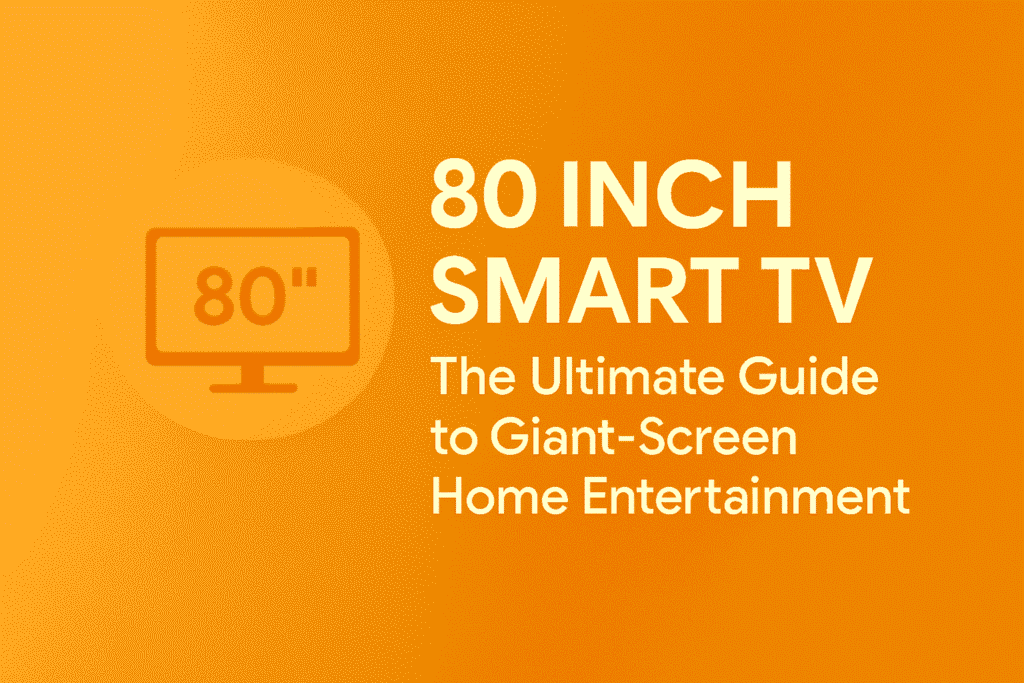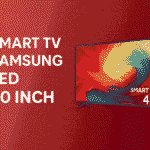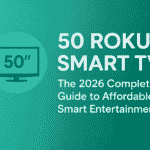The television has evolved into more than just a screen; it’s the centrepiece of modern living rooms, gaming dens, and home cinemas. In 2025, one of the most sought-after display sizes is the 80 inch smart TV — a breathtaking combination of massive scale, cutting-edge clarity, and intelligent features that redefine how we experience movies, sports, and streaming content.
This comprehensive guide explores everything you need to know before buying an 80-inch smart TV: its advantages, the best models of 2025, setup tips, viewing distance, performance comparisons, and how to transform your space into a personal cinema.
1. Why an 80 Inch Smart TV Is the Future of Home Entertainment
Bigger screens are not just about bragging rights — they’re about immersion. At 80 inches, you’re no longer simply watching a show or movie; you’re inside it. The human field of vision is filled almost completely at this size when viewed from the right distance, creating an authentic cinematic effect.
Key reasons consumers are upgrading to 80-inch TVs:
- Cinematic immersion: Every detail feels larger-than-life — from sweeping landscapes to subtle facial expressions.
- Perfect for 4K and 8K content: The large surface fully reveals the advantages of ultra-high-definition resolution.
- Gaming like never before: Games look more realistic, and split-screen multiplayer becomes practical.
- Ultimate sports experience: Feel like you’re sitting courtside or in the front row of a stadium.
- A prestige centrepiece: A well-mounted 80″ smart TV instantly elevates the style of any room.
Industry reports show that large-format TVs above 75 inches are among the fastest-growing categories in 2025. As prices drop, the 80-inch range is becoming more accessible to enthusiasts worldwide.
2. Ideal Viewing Distance and Room Requirements
Before buying, measure your space carefully. The recommended viewing distance for an 80-inch 4K TV is around 3 to 4 metres (10–13 feet). This ensures optimal pixel density without strain.
| Resolution | Ideal Distance | Viewing Angle |
|---|---|---|
| 4K UHD | 3.0 – 3.8 m | ~30°–40° |
| 8K UHD | 2.0 – 2.8 m | ~45° |
| 1080p HD | 4.5 – 5.0 m | ~25° |
To achieve maximum comfort:
- Keep the centre of the screen at eye level (around 110 cm from the floor).
- Ensure adequate wall support (VESA 600 × 400 or 800 × 400 mount).
- Leave at least 20 cm clearance around the back and sides for ventilation.
- Use anti-glare curtains if your room has strong sunlight.
3. Types of 80 Inch Smart TVs Available in 2025
The market in 2025 offers multiple panel technologies catering to different budgets and preferences.
3.1 LED (LCD-based)
Traditional back-lit panels, ideal for affordability and reliability. Best for bright environments and long usage hours.
Pros: Long lifespan, excellent brightness, lower cost.
Cons: Limited black levels compared to OLED.
3.2 QLED (Quantum Dot LED)
Samsung and TCL’s quantum-dot technology enhances colour saturation and brightness dramatically.
Pros: Rich colours, high brightness, long durability.
Cons: Slight blooming around bright objects on dark backgrounds.
3.3 Mini-LED
Uses thousands of miniature LEDs for precise local dimming. The most balanced tech between LED and OLED.
Pros: Exceptional contrast and HDR, energy-efficient.
Cons: Premium price.
3.4 OLED
Each pixel emits its own light, achieving perfect blacks and infinite contrast.
Pros: Unbeatable contrast, ultra-slim design.
Cons: Risk of burn-in, higher cost at this size.
3.5 Micro-LED
Emerging top-tier tech — self-emissive like OLED but without burn-in risk.
Pros: Peak brightness + perfect blacks.
Cons: Still expensive, limited availability in 2025.
4. The Best 80 Inch Smart TV Models of 2025
| Brand & Model | Display Type | Resolution | Refresh Rate | HDR | Ideal Use |
|---|---|---|---|---|---|
| Samsung QN90D Neo QLED 80″ | Mini-LED | 4K | 120 Hz | HDR10+, HLG | Movies, sports, gaming |
| LG C4 OLED 80″ | OLED | 4K | 120 Hz | Dolby Vision, HDR10 | Cinematic visuals |
| Sony Bravia XR X95L 80″ | Mini-LED | 4K | 120 Hz | Dolby Vision | Balanced all-rounder |
| TCL QM850G QLED 80″ | QLED | 4K | 144 Hz | HDR10+, Dolby Vision | Gaming & streaming |
| Hisense U8N 80″ ULED X | Mini-LED | 4K | 144 Hz | HDR10+, Dolby Vision | Affordable premium |
These 2025 models dominate expert recommendations for combining performance, price, and innovation.
5. Picture Quality: What Makes an 80-Inch Smart TV Exceptional
Brightness and HDR
At this size, brightness levels above 700 nits are essential for HDR content.
Mini-LED and QLED achieve 1,000–2,000 nits, reproducing brilliant sunlight, reflections, and firelight realistically.
Colour Volume
Quantum dots and OLEDs reproduce 100% of DCI-P3 colour space, matching cinema projectors.
The 80″ canvas amplifies subtle gradations, giving 3D realism to skin tones and nature scenes.
Motion Handling
Most 80-inch models offer 120 Hz or higher native refresh rates. Motion smoothing technologies like Samsung’s Motion Xcelerator Turbo+ or Sony’s XR Motion Clarity ensure clear sports and gaming action.
Viewing Angles
OLED and advanced IPS Mini-LED models maintain colour accuracy up to 178°. Perfect for large families or group viewing.
6. Smart Features and Operating Systems
In 2025, smart TVs operate more like full computers than displays. Here’s what major platforms provide:
| OS | Used By | Strength |
|---|---|---|
| Tizen OS 8 | Samsung | Fast, app-rich, smart-home integration |
| webOS 24 | LG | Minimalist, intuitive, supports AirPlay & Alexa |
| Google TV | Sony, TCL, Hisense | Universal search, Chromecast built-in |
| Vidaa U8 / Fire TV | Hisense, Amazon models | Budget-friendly, Alexa-centric |
All major systems now support:
- Voice assistants (Google, Alexa, Bixby)
- Multi-view split screen
- Screen mirroring (Android/iPhone)
- Cloud gaming (Xbox Cloud, GeForce Now)
- Smart-home control
7. Sound Quality: Matching Audio to Visual Scale
A screen this large demands powerful audio.
- Integrated 2.2 or 4.2 channel speakers on high-end models deliver decent clarity.
- Dolby Atmos & DTS:X support creates 3D spatial sound.
- Q-Symphony (Samsung) or WOW Orchestra (LG) sync TV + soundbar speakers.
- For the best results, pair with a soundbar like Samsung HW-Q930D or Sony HT-A7000.
Consider an AV receiver with 5.1.2 or 7.1 setup if building a home theatre.
8. Connectivity and Ports
An 80-inch TV usually includes:
- 4× HDMI 2.1 ports
- 3× USB ports
- 1× Optical audio out
- Ethernet port
- Wi-Fi 6E + Bluetooth 5.3
- eARC for high-bitrate Dolby Atmos
Gamers and streamers alike benefit from low-latency HDMI 2.1 and stable Wi-Fi 6E networks for seamless 4K streaming.
9. Gaming Performance
Modern consoles like PS5 and Xbox Series X thrive on large 120 Hz 4K panels.
Features to look for:
- ALLM (Auto Low Latency Mode)
- VRR (Variable Refresh Rate)
- FreeSync / G-Sync support
- Game Mode Dashboard
Input lag on the best models is as low as 5–10 ms, making an 80″ smart TV a genuine gaming monitor replacement.
10. Installation and Setup Tips
Because of its size and weight (45–60 kg), plan installation carefully.
- Wall mount using reinforced brackets rated for 80″ or more.
- Two-person installation is mandatory.
- Cable management with conduits or trunking improves aesthetics.
- Stable Wi-Fi connection ensures lag-free streaming.
- Update firmware after setup.
- Adjust picture presets: Movie mode for cinema, Standard for news.
- Use an AVR or soundbar to complement visuals.
11. Energy Efficiency and Sustainability
Despite their size, modern 80-inch TVs are surprisingly efficient.
- Mini-LEDs cut energy use by 30% versus traditional LEDs.
- OLEDs consume less during dark scenes.
- Eco modes automatically reduce brightness in idle conditions.
- Most brands include recyclable packaging and solar-powered remotes.
Average consumption: 130–250 W depending on brightness mode — far less than older plasma screens.
12. Maintenance and Longevity
Follow these habits for a long-lasting panel:
- Keep brightness below 80% for routine use.
- Avoid static logos or news tickers for extended hours.
- Clean gently with a microfiber cloth.
- Ensure airflow to prevent overheating.
- Use surge protectors during storms.
Most quality 80-inch LEDs last over 60 000 hours — more than 10 years of daily use.
13. Comparing 75″ vs 80″ vs 85″ TVs
| Size | Recommended Room Width | Visual Impact | Best Use |
|---|---|---|---|
| 75″ | Medium-large | Strong | General family viewing |
| 80″ | Large | Cinematic | Dedicated entertainment space |
| 85″ | Very large | Extreme | Home theatre installations |
For most users, 80″ hits the perfect middle: dramatic yet manageable.
14. Pros and Cons of an 80-Inch Smart TV
Pros
- Massive cinematic immersion
- Ideal for 4K/8K content
- Excellent for gaming and sports
- Adds prestige and value to your living space
- Smart features streamline entertainment
Cons
- Requires ample wall space and sturdy mounting
- Higher power consumption than small TVs
- Premium pricing for OLED/Mini-LED versions
15. Estimated Pricing and Value
| Category | Type | Typical Price (USD) |
|---|---|---|
| Entry (LED) | TCL / Hisense | $1,200 – $1,600 |
| Mid-range (QLED) | Samsung / TCL | $1,800 – $2,500 |
| Premium (Mini-LED) | Samsung / Sony | $2,800 – $3,500 |
| Ultra-premium (OLED / Micro-LED) | LG / Samsung | $4,000 – $6,500 |
While initial cost may seem high, cost per inch and lifespan make large TVs excellent long-term value.
16. Real User Experiences
Owners of 80-inch smart TVs frequently describe them as transformative. Movie nights become social events, and 4K content feels lifelike. Gamers enjoy immersive realism. Even standard HD content, thanks to upscaling, looks cleaner.
Common praises:
- “Feels like a cinema at home.”
- “Perfect for sports weekends.”
- “Tizen OS is fast and intuitive.”
Minor complaints:
- Requires two people for installation.
- Needs good ambient control to avoid reflections.
17. How to Create the Ultimate Home Cinema
To complement your 80-inch smart TV:
- Sound: Dolby Atmos 5.1.2 soundbar or surround system.
- Lighting: LED bias lights behind the TV to reduce eye strain.
- Seating: Recliners or couch 3–4 m away.
- Streaming gear: Fiber Wi-Fi or Ethernet for stable 4K playback.
- Décor: Dark wall colours enhance perceived contrast.
These tweaks turn your living room into a professional-grade home theatre.
18. Future Innovations Beyond 2025
The next wave includes:
- 8K resolution mainstreaming on 80″ displays.
- AI calibration for real-time tone and motion adjustments.
- Transparent micro-LEDs for multi-use glass panels.
- Integrated cameras for fitness and video calling.
- Solar energy integration in frames.
Your 80-inch smart TV could soon double as a gaming monitor, conferencing display, and art piece simultaneously.
19. Who Should Buy an 80-Inch Smart TV
This size suits:
- Home theatre lovers wanting immersion.
- Gamers craving large-screen realism.
- Families with spacious living rooms.
- Professionals using TVs for design, presentations, or creative editing.
It’s not ideal for small apartments or close-up viewing, but in the right space, it delivers a transformative experience.
20. Final Verdict
The 80 inch smart TV represents the pinnacle of home entertainment in 2025 — a product of technical precision and aesthetic sophistication. It combines cinematic visuals, powerful smart software, and elegant design into one commanding screen.
If you have the room and budget, there’s no better upgrade for your lifestyle. Choose a model that balances brightness, colour accuracy, and connectivity for your specific needs — whether it’s a Samsung Neo QLED for gaming, an LG OLED for movies, or a Sony Mini-LED for balanced performance.
Once installed, you’ll never view home entertainment the same way again.
An 80-inch smart TV doesn’t just show content — it creates experiences.



